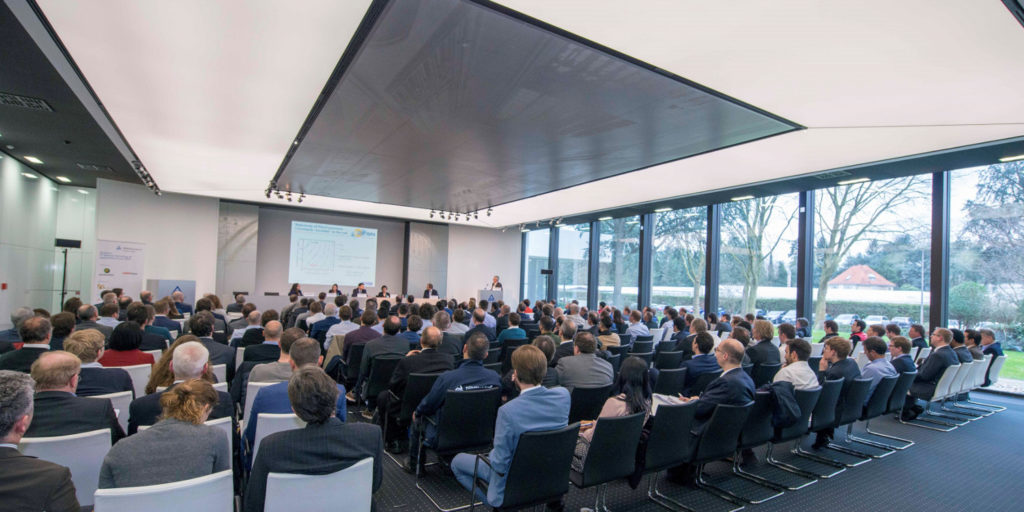Anyone who buys, produces or plans PV systems today has to deal with some of the new technological developments that have been revolutionizing and changing the market for several years. This is as important today, as it has been in recent years.
In order to keep up with such fast development, the latest technologies and trends should be constantly observed and evaluated. This was the conclusion of the “Module Technology & Applications Forum,” held by TÜV Rheinland and NRW this Monday and Tuesday in Cologne.
For the first time, the workshop was held in English, and not in German as in previous years, and for an international audience. According to organizer, Florian Reil, the workshop was a success, with 60% of the 220 participants coming from outside of Germany, from 25 countries.
“Investment goods should be evaluated carefully,” said Reil, who is also the Business Unit Manager Solar Innovation/Large Scale Projects at TÜV Rheinland. “These goods must work for a long time.” For this reason, it is crucial to know the current technical developments, and the new results concerning quality problems and assurance, and to understand new approaches.
Backsheet thickness
One example is backsheets: For cost reasons, some manufacturers have reduced PET layers by up to a quarter of the original thickness in certain backsheets in recent years, explains Jörg Althaus, Business Unit Manager Solar Energy at TÜV Rheinland. Although backsheets may pass tests, errors could occur in the field.
With the new IEC 61215 standard, there is now an additional requirement that a certain layer of thickness for the insulation material should not be undercut. But that does not necessarily have to be just PET.
Degradation
Popular content
Another example is Light Induced Degradation (LID), which was discussed during the workshop. For monocrystalline PERC modules, the unanimous opinion is that the problem is largely under control. But not for multicrystalline PERC products, however, where light-induced degradation can cause modules to lose up to 10% of their power in the first few months, according to Peter Fath, CEO of engineering firm RCT Solutions. The effect is not yet fully understood and it will probably take another two years to get it completely under control.
Tabea Luka of the Fraunhofer CSP in Halle said the same. She and her colleagues have developed a test that analyzes both materials and modules for LID. However, this requires 500 hours for multicrystalline PERC modules. The institute is hoping for discussion on a new standard.
Overtaken
In this field too, however, technological development has overtaken standardization. The IEC 61215 standards prescribe preconditioning at 50 degrees, with a tolerance window of plus/minus 10 degrees, according to Jörg Althaus. At 40 degrees, light-induced degradation is not seen with PERC modules. Therefore, when TÜV Rheinland tests modules for investors, it goes to the upper limit of the temperature range.
With module technology, quality control is also progressing. Anyone measuring the performance of a module must be able to trace the calibration back to one of the national calibration labs, for example, to the German PTB in Braunschweig. The accuracy of this original calibration, and the accuracy of measurements along the calibration chain at the end, defines the accuracy of the performance measurements in production.
This has improved, since the calibration at the beginning of the chain is now much more accurate than it was a few years ago, at plus/minus 0.25%, according to Harald Müllejans of the European Joint Research Center. This then leads, at the end of the manufacturing chain in production, to an uncertainty which is nowadays around 3%.
In practice, Müllejans told the audience to take a closer look at data sheets. As an example, he cites one in which accuracy is given at 1%. This is the uncertainty between the measurements on the modules, which would be sorted in production into performance classes, he explained. This, however, is not the absolute measurement uncertainty, which could not be less than 3%. This must also be noted on the data sheet, he asserted.
This content is protected by copyright and may not be reused. If you want to cooperate with us and would like to reuse some of our content, please contact: editors@pv-magazine.com.


Thanks for this article. In particular, for the focus on uncertainty. This is something that is generally not very well understood and has an impact on performance estimation, not only of the modules but on the entire installations.